A favorite at izakaya restaurants, Yaki Onigiri are Japanese rice balls that are pan-grilled and glazed in savory soy sauce. With a crispy crust on the outside and tender rice on the inside, these rice balls are simply irresistible and easy to make at home!
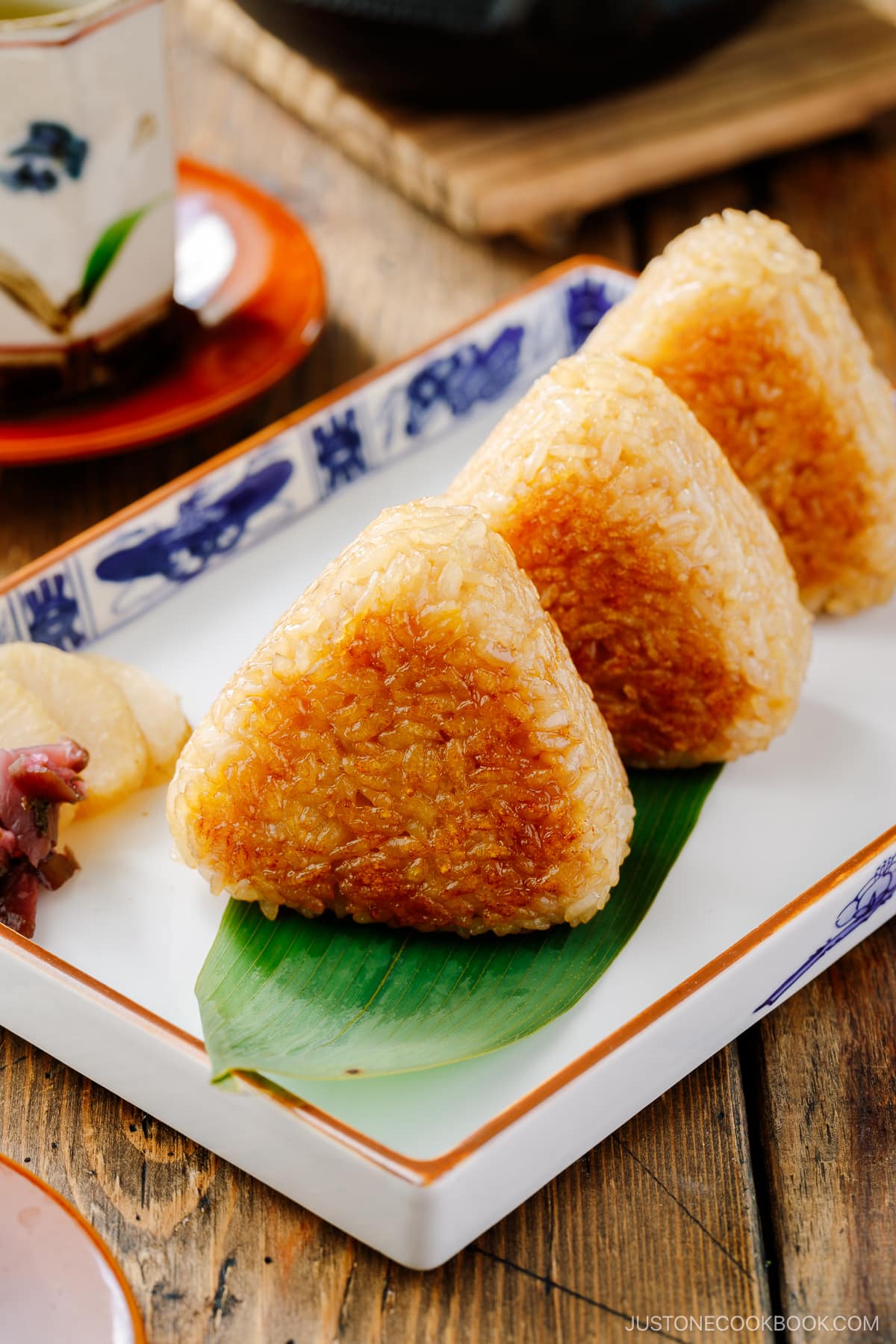
Have you ever tried Yaki Onigiri (焼きおにぎり)? These grilled rice balls are a beloved snack and lunchtime delight in Japan, frequently gracing the menus of BBQ parties and izakaya establishments.
If you have an affinity for rice and grilled food, you will enjoy yaki onigiri. Picture these delectable rice balls gently grilling, their exteriors crisping to a golden brown while the rice within remains warm, tender, and irresistibly soft. A light brush of a savory glaze elevates the flavors, making them a most delicious treat!
Table of Contents
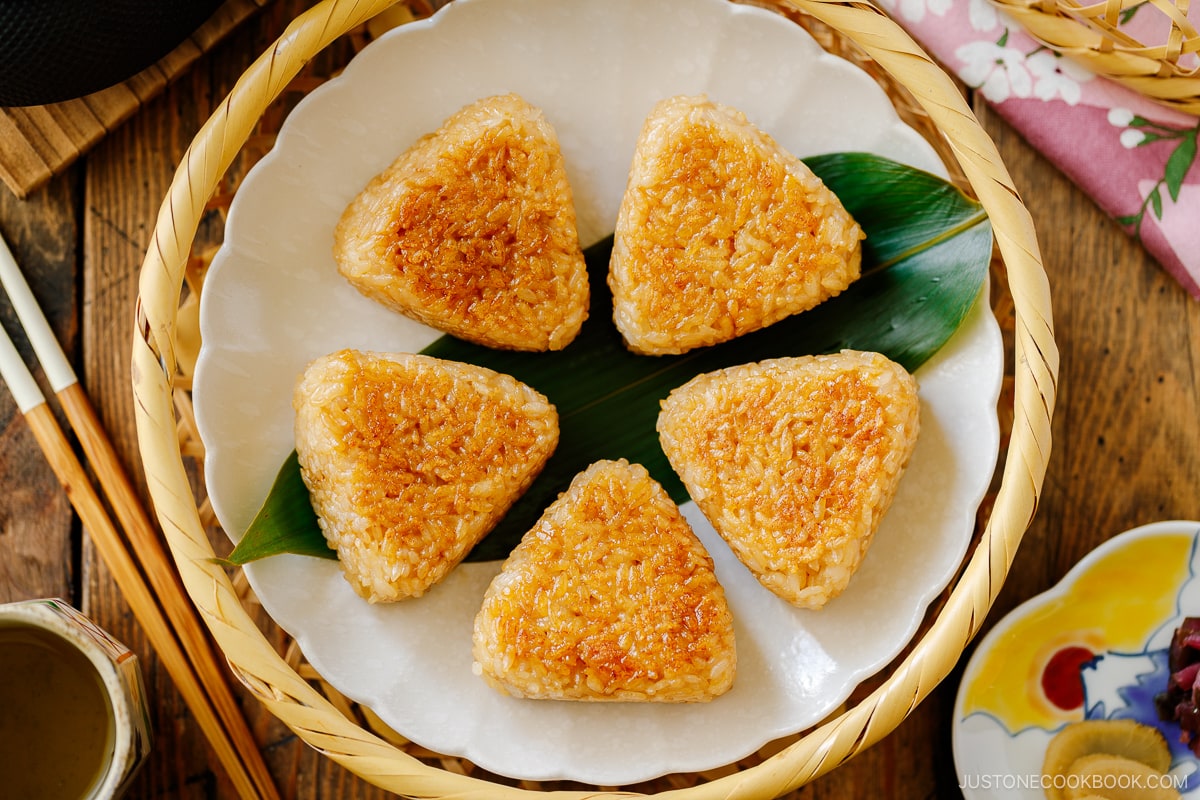
What’s Yaki Onigiri?
The term “yaki” originates from the Japanese word for “grilled,” as seen in other popular dishes such as Teriyaki, Yakisoba, Yakiniku, and Yakitori. On the other hand, “onigiri” translates to “rice balls.” Therefore, yaki onigiri quite literally means grilled rice balls.
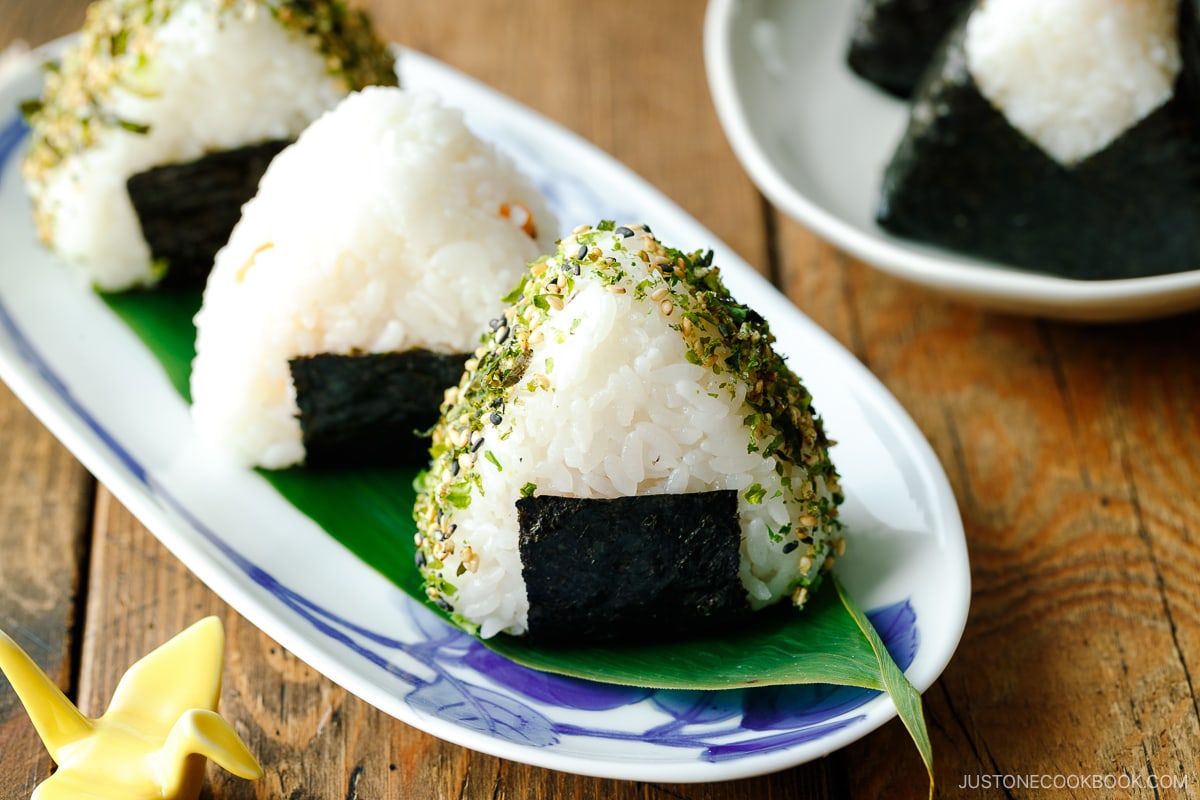
In the traditional preparation of yaki onigiri, rice balls are grilled over charcoal until the rice attains a desirable browned and crispy texture. Subsequently, they are brushed with either soy sauce or a miso glaze, allowing the seasoning to caramelize, creating a golden crust on the exterior.
Most Japanese do not have charcoal or a grill in their homes, so yaki onigiri is grilled using a frying pan. You’d start by shaping cooked short-grain white rice into triangular or oval shapes, akin to regular onigiri (my recipe here), before pan-grilling them. It’s every bit as straightforward to make as it sounds!
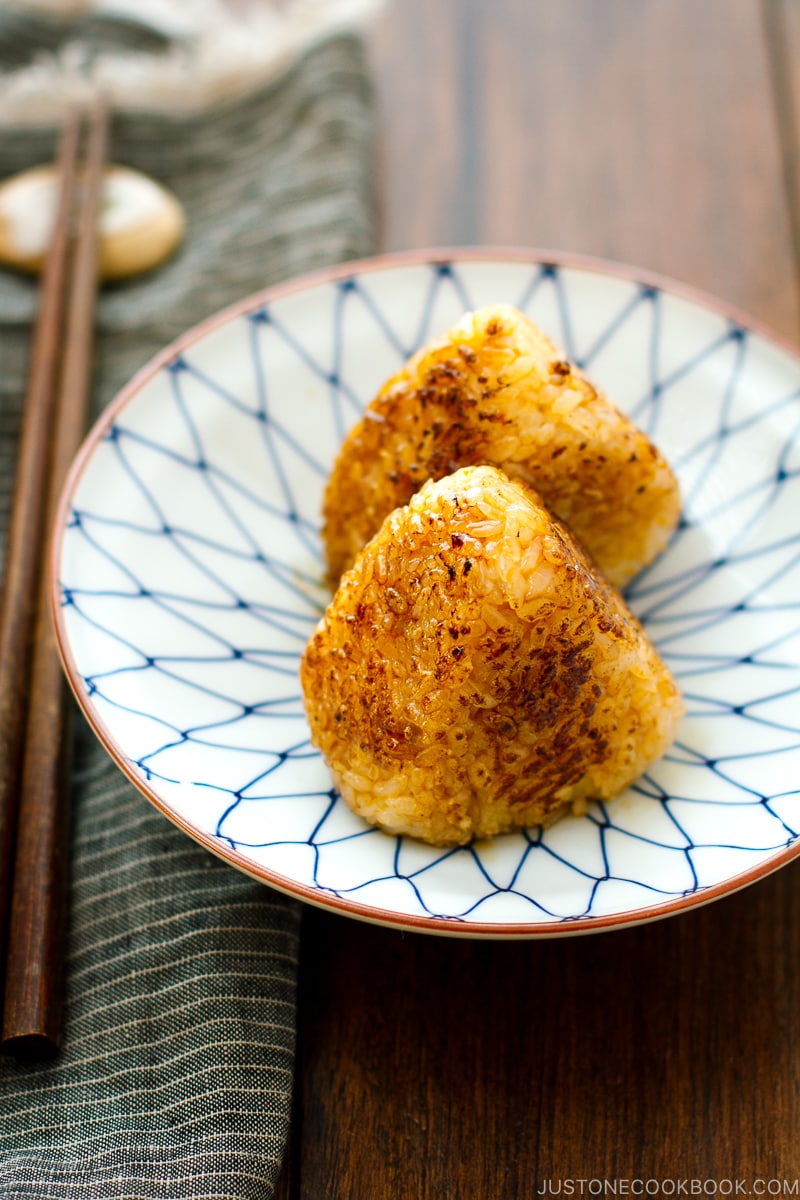
Ingredients for Yaki Onigiri
- Japanese short-grain rice (cooked)
- Seasonings: soy sauce, sugar, salt, and sesame oil
- Soy sauce glaze: soy sauce and sesame oil
How to Make Yaki Onigiri at Home
- Combine the cooked rice and the seasonings. Mix it all together without making it mushy.
- Make onigiri with seasoned rice. I’ll show you two ways in this recipe: using an onigiri mold and plastic wrap. You can choose either method.
- In a frying pan lined with parchment paper, place the rice balls and grill on all sides on medium-low heat until crispy and golden.
- Brush the soy sauce glaze on the rice balls and sear the brushed surface. Be careful not to burn.
- Transfer to a plate and enjoy while hot!
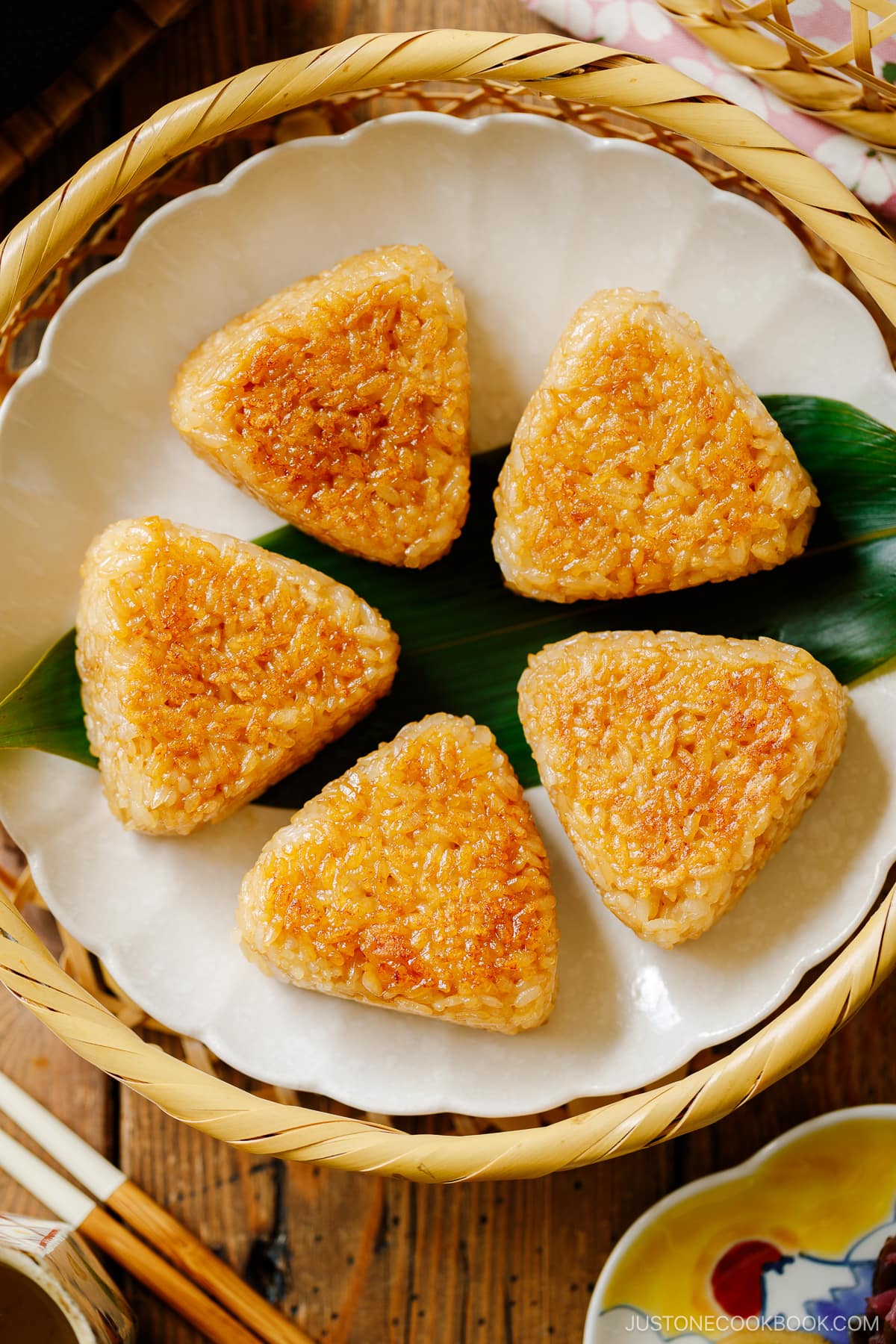
Filling or No Filling in Yaki Onigiri
These grilled rice balls can be made with fillings, but typically, it is prepared with plain or seasoned rice. I prefer mine without filling as I find filling can sometimes distract the enjoyment. Then again, the choice is yours.
Because it’s all about simplicity, you want to start with quality Japanese short-grain rice. Forming the onigiri is not too challenging. In the recipe section below, I’ve shared step-by-step pictures and tips on how to form the rice balls, so you will master it in no time. Once you have the rice balls shaped, you just need to place them on the grill, brush them with the sauce, and leave them to crisp up.
The Glaze Variations
Although yaki onigiri is commonly glazed with soy sauce or miso (I have a Miso Yaki Onigiri recipe), you can be creative with different flavors. Here are my suggestions!
- Eel Sauce. I love my Homemade Unagi Sauce. The savory aroma and taste of this caramelized sweet soy sauce blend perfectly with white rice, especially if you like it sweeter.
- Teriyaki Sauce. Definitely make my Homemade Teriyaki Sauce for this!
- Negi Miso. My Homemade Negi Miso is so delicious. I may put it inside the onigiri, too, but you can definitely slather on the outside and sear a bit.
- All Purpose Miso Sauce. This Homemade All Purpose Miso Sauce goes well with everything.
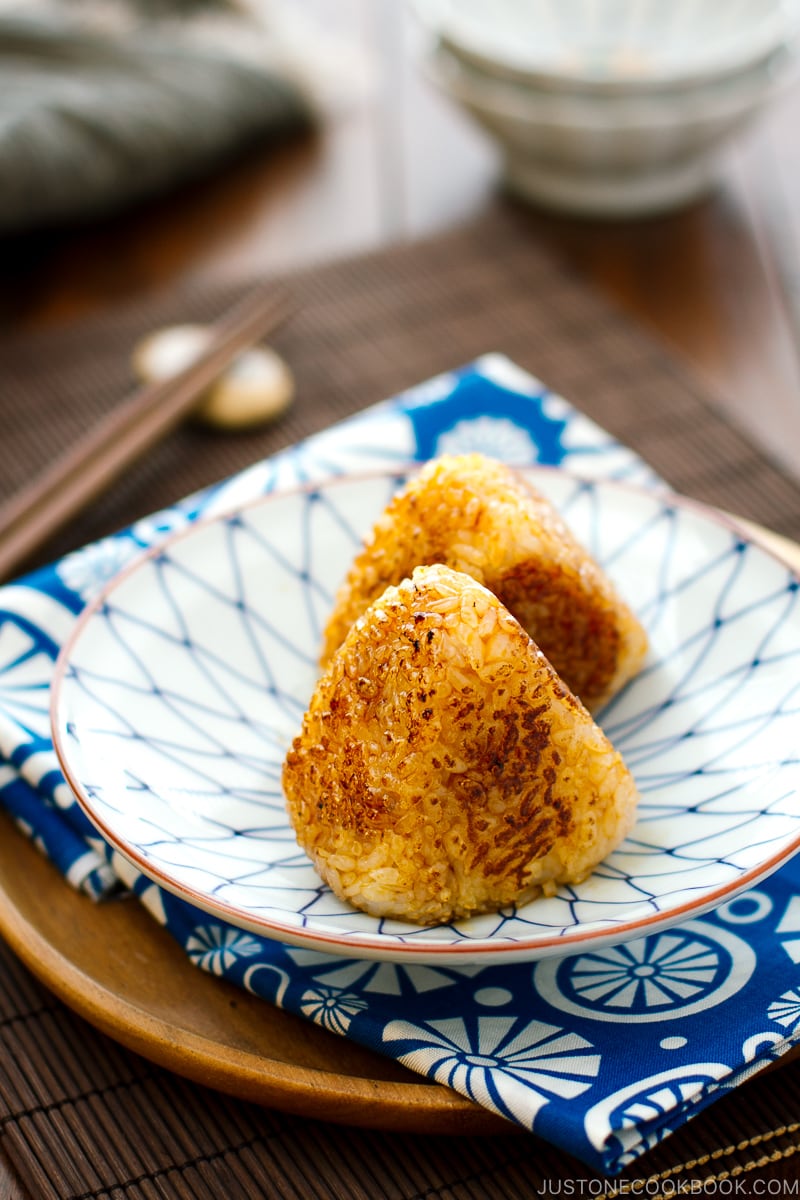
What to Do with Leftover Yaki Onigiri
Make and freeze yaki onigiri ahead of time so you can enjoy this Yaki Onigiri Chazuke as a quick meal or midnight snack.
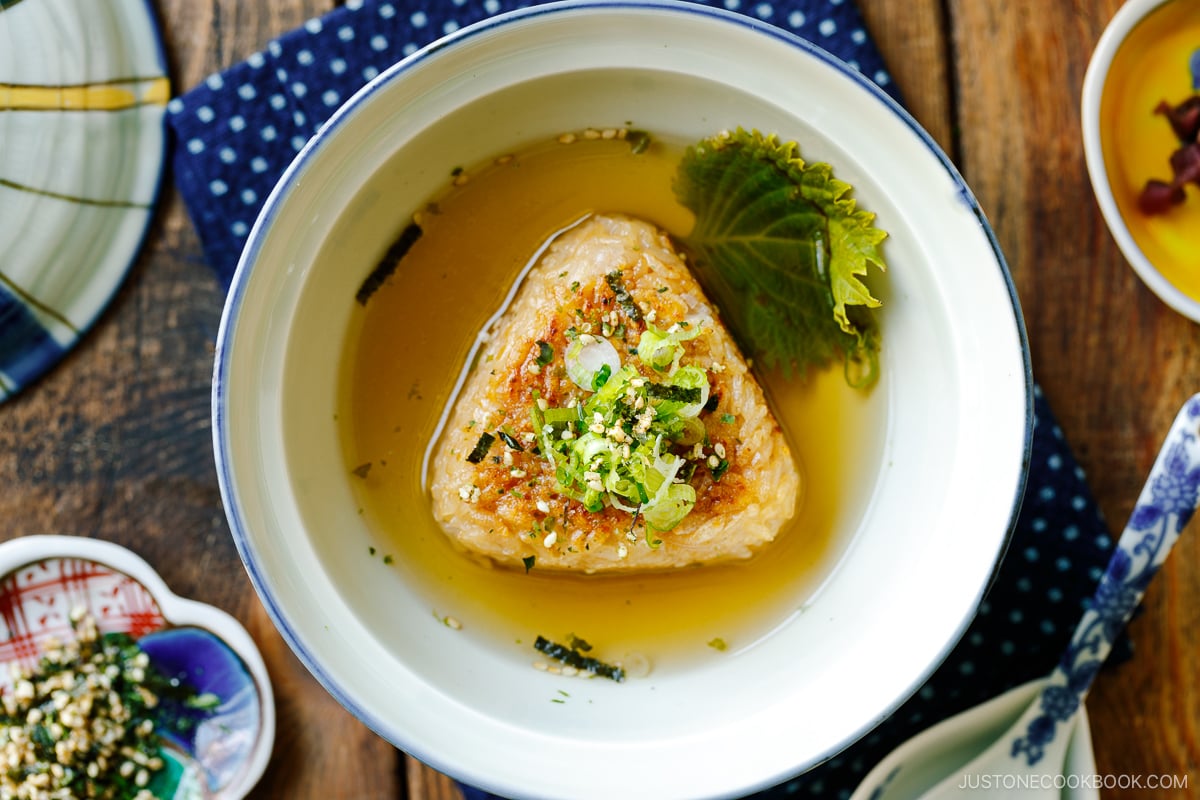
Yaki Onigiri Chazuke is a Japanese comfort dish. It consists of warm dashi soup poured over a crispy Yaki Onigiri and garnished with savory toppings.
What to Serve with Yaki Onigiri
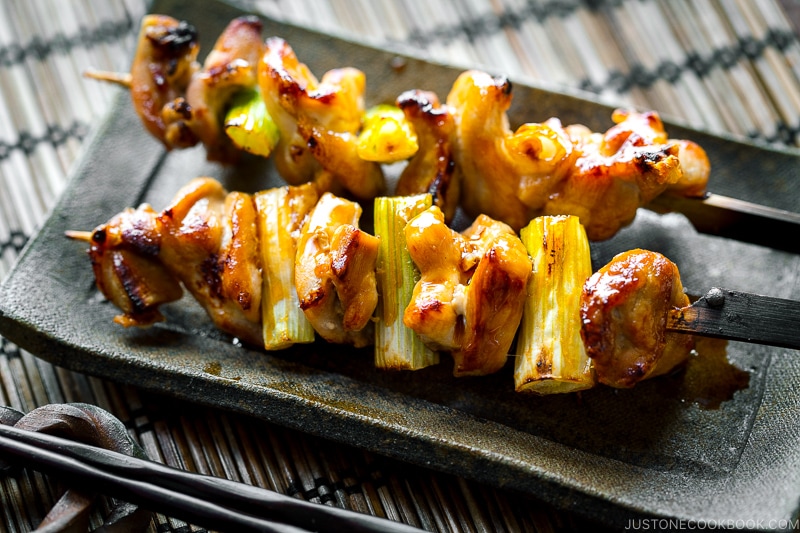
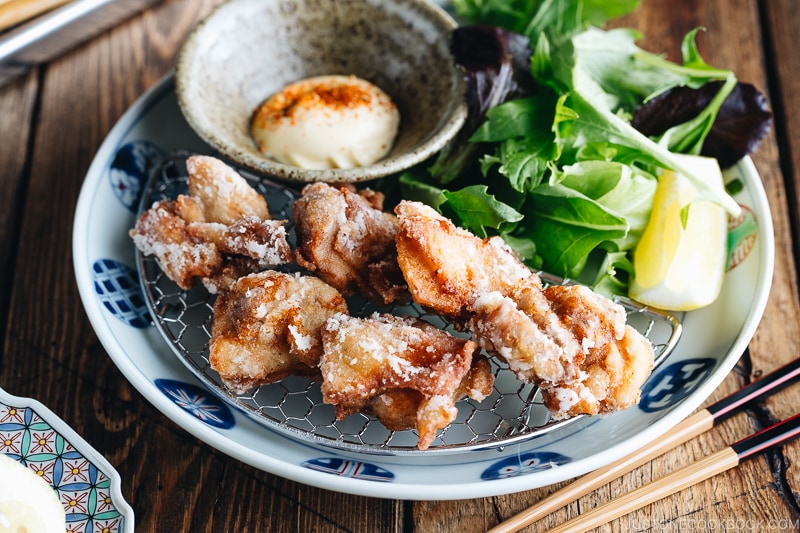
I can just devour yaki onigiri on their own, but for a balanced meal, you can pair them with:
- Yakitori
- Yakitori-Style Grilled Vegetables
- Karaage (Japanese Fried Chicken)
- Agedashi Tofu
- Spicy Edamame
- Hamachi Crudo
- Oden (Japanese Fish Cake Stew)
What is the Best Rice Cooker
To make the perfect rice for yaki onigiri, I like to use my Zojirushi NP-NWC10XB Rice Cooker. It makes fluffy rice every time and is the best Japanese rice cooker I’ve ever used! You can get it on Amazon for $458.29, and it’s well worth it if you cook a lot of rice.
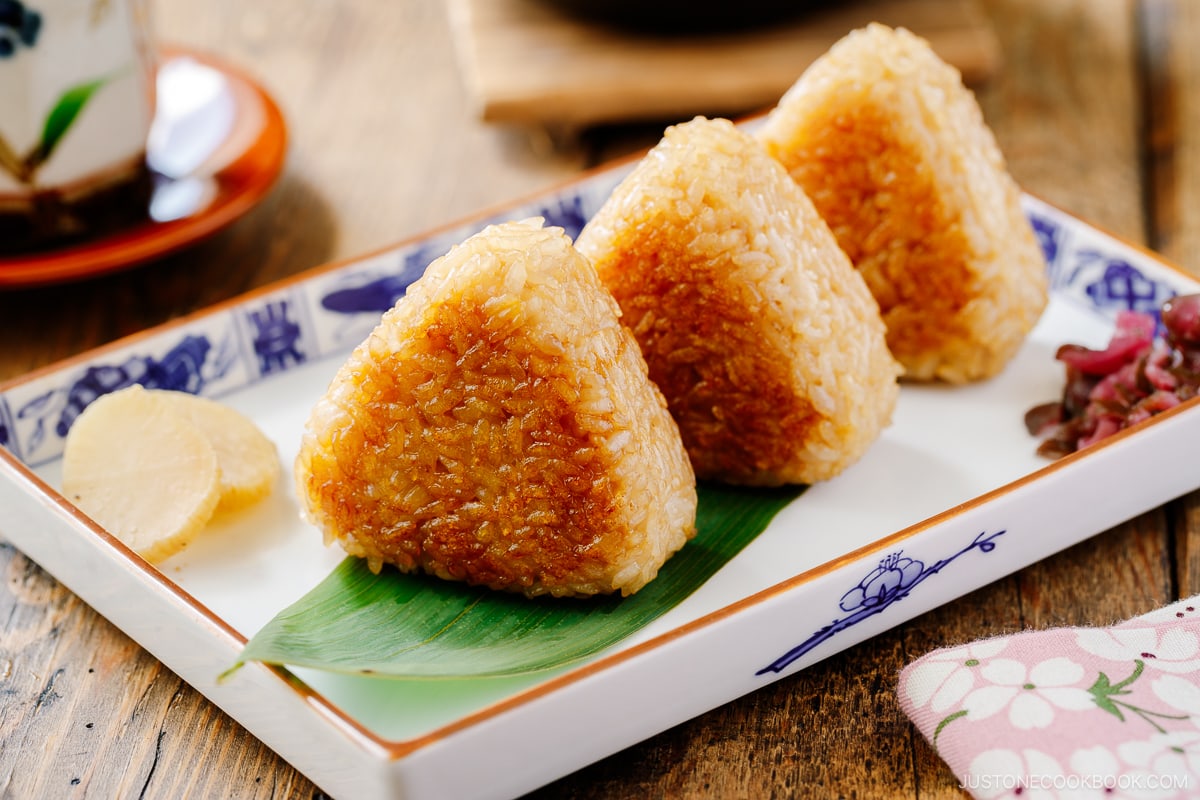
Wish to learn more about Japanese cooking? Sign up for our free newsletter to receive cooking tips & recipe updates! And stay in touch with me on Facebook, Pinterest, YouTube, and Instagram.
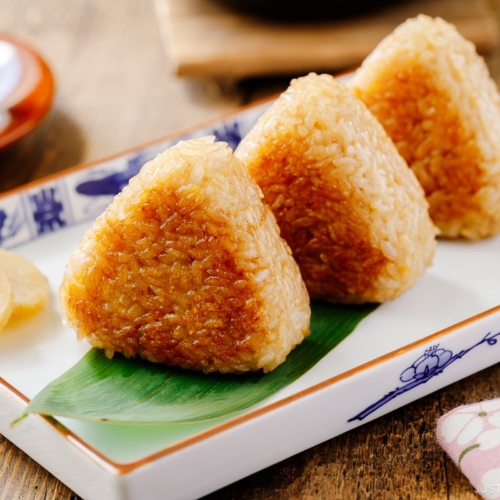
Yaki Onigiri (Grilled Rice Ball)
Video
Ingredients
For the Steamed Rice
- 2¼ cups uncooked Japanese short-grain white rice (3 rice cooker cups, 540 ml; to cook 2 rice cooker cups of rice instead, see measurements below)
- 2½ cups water (for 2 rice cooker cups of rice, use 1⅔ cups (400 ml) water)
For Seasoning the Rice
- 3 Tbsp soy sauce (or use 2 Tbsp for 2 rice cooker cups of rice)
- 1 Tbsp sugar (or 2 tsp for 2 rice cooker cups)
- 1 Tbsp toasted sesame oil (or 2 tsp for 2 rice cooker cups)
- ¼ tsp Diamond Crystal kosher salt (or ⅛ tsp for 2 rice cooker cups)
For the Glaze
- 1 Tbsp soy sauce
- 1 tsp toasted sesame oil
Instructions
Before You Start…
- Japanese short-grain white rice requires a soaking time of 20–30 minutes. The rice-to-water ratio is 1 to 1.1 (or 1.2) for short-grain white rice. Please note that 2¼ cups (450 g, 3 rice cooker cups) of uncooked Japanese short-grain rice yield 6⅔ cups (990 g) of cooked white rice. This is enough for 9 onigiri rice balls (typically 110 g each). Optional: To make 5–6 rice balls, cook 1½ cups (300 g, 2 rice cooker cups) of uncooked Japanese short-grain rice in 1⅔ cups water (400 ml) to yield 4⅓ cups (660 g) of cooked white rice.
- Cook the rice; see how with a rice cooker, pot over the stove, Instant Pot, or donabe. To my rice cooker, I added 2½ cups water to 2¼ cups uncooked Japanese short-grain white rice. Once the rice is cooked, gather all the ingredients.

To Season the Rice
- Combine 3 Tbsp soy sauce and 1 Tbsp sugar in a small bowl and microwave until the mixture is hot, about 30–60 seconds. Whisk it all together until the sugar dissolves.

- Add 1 Tbsp toasted sesame oil and ¼ tsp Diamond Crystal kosher salt and mix it all together.

- Transfer the hot cooked rice to a large bowl and add the seasoning mixture.

- With a rice paddle, use a slicing motion to combine the seasoning and cooked rice well. Now, you‘re ready to shape the rice balls. Note: Be sure to let the cooked rice cool a little bit until you can hold it without burning your hands. Rice must be hot or warm when making onigiri in order to hold its shape.

To Shape the Rice Balls
- With an Onigiri Mold: Prepare a small bowl filled with water. Soak the onigiri mold and lid in the water to moisten so the rice doesn‘t stick to it. Remove the mold and drain the excess water.

- Fill the onigiri mold with the hot seasoned rice all the way to the top edge, making sure to fill the corners. Cover with the lid and push down firmly. You should feel a slight resistance; if not, you may want to add a bit more rice.

- Remove the lid. Flip over the mold onto a baking sheet or plate lined with parchment paper. Then, push the “button” on the mold‘s bottom to release your onigiri. Tip: Always dip your fingers in water before touching the onigiri to prevent the rice from sticking to them.

- Repeat with the remaining rice.

- Now, firmly hand-press the rice balls to keep them from falling apart while grilling. For Yaki Onigiri, you‘ll want to press the rice ball a bit more tightly than you would a regular onigiri. First, moisten both palms with a bit of water to prevent the rice from sticking. Then, pick up a rice ball in your left (non-dominant) hand. Place your right (dominant) hand on top of the rice in a “mountain" shape and gently press the triangle corner. At the same time, squeeze the fingers and heel of your bottom (left) hand to gently press the sides flat.Now, rotate the triangle corner you just pressed toward you (clockwise, if you‘re right-handed). The tip of the second corner will now be pointing up. Repeat the above “press and rotate” steps to hand press the second triangle corner and then the third, always keeping your left hand on the bottom and your right hand on top. Press and rotate a final 2–3 more times to finish.

- In the image below, the top row is hand pressed while the bottom row is not.

- If you don‘t want to touch the rice with your hands, you can press the onigiri with plastic wrap. Place a piece of plastic wrap on the working surface, wet your fingers, and place the onigiri in the middle.

- Gather the corners of the plastic wrap and twist it a few times to tighten it around the rice. Form the rice into a triangle shape in the same manner that I described above.

- Without an Onigiri Mold: You also can use plastic wrap to shape the onigiri instead of using a mold. Place a piece of plastic film on the working surface, wet your fingers, and put the rice on top. Gather the corners of the plastic film and twist it a few times to tighten it around the rice.

- Form the rice into a triangle shape through the plastic in the same manner that I described above for hand-pressing the onigiri. Repeat with the remaining rice. Tip: To shape the onigiri with your hands the traditional way, see the step-by-step instructions and images in my Onigiri (Japanese Rice Balls) post.

To Pan-Grill the Onigiri
- Combine 1 Tbsp soy sauce and 1 tsp toasted sesame oil for the glaze. Place a sheet of parchment paper on a large frying pan.

- Gently place the rice balls on the parchment paper and grill on medium-low heat. Grill the onigiri until all sides are crispy and lightly browned. Once browned on the bottom, turn them over (I use two silicone spatulas). Don’t flip them until browned; work on one side at a time and avoid handling them too much, which may cause the onigiri to break into pieces.

- Rotate the onigiri to grill all sides and make sure they become crispy.

- Once they are nicely toasted and lightly brown, turn the heat to low (or turn off the heat). Brush the onigiri sides with the soy sauce glaze, then turn over to grill on the sauce side. Then, brush on the other side.

- Be careful not to burn the onigiri after you brush it with the glaze. Optionally, you can brush them with my homemade unagi sauce and teriyaki sauce. Your Yaki Onigiri are now ready to enjoy.

To Store
- Rice gets hard when you refrigerate it. You can individually wrap the Yaki Onigiri in plastic wrap and cover them with a thick kitchen towel and store in the refrigerator for up to 2 days. The towel will prevent the rice from getting too cold and keep the food cool but not cold. You can also store the Yaki Onigiri that are individually plastic-wrapped in the freezer for up to a month. When you‘re ready to eat, bring it back to room temperature and reheat in a microwave or frying pan.

Nutrition
Editor’s Note: This post was originally published on June 25, 2012. It’s been republished with new images, more helpful content, and a revised recipe on September 18, 2023. A new video was added to the post on March 23, 2024.
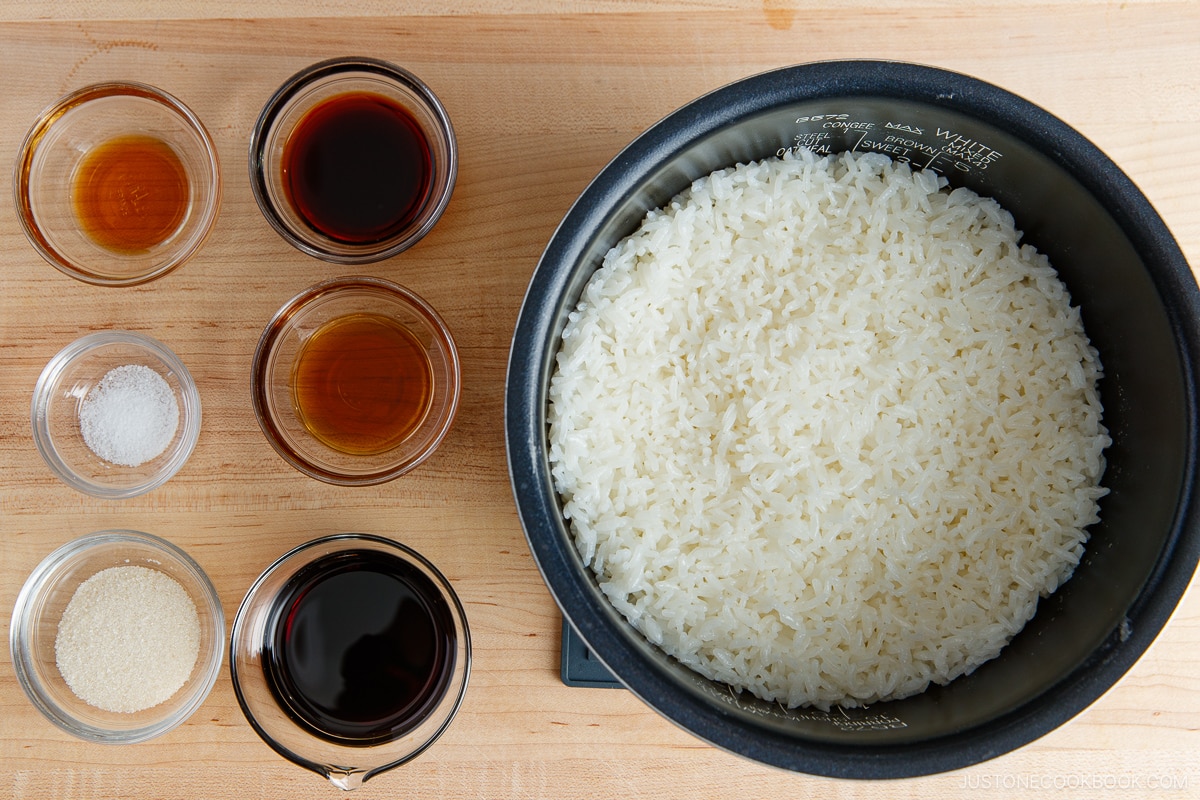
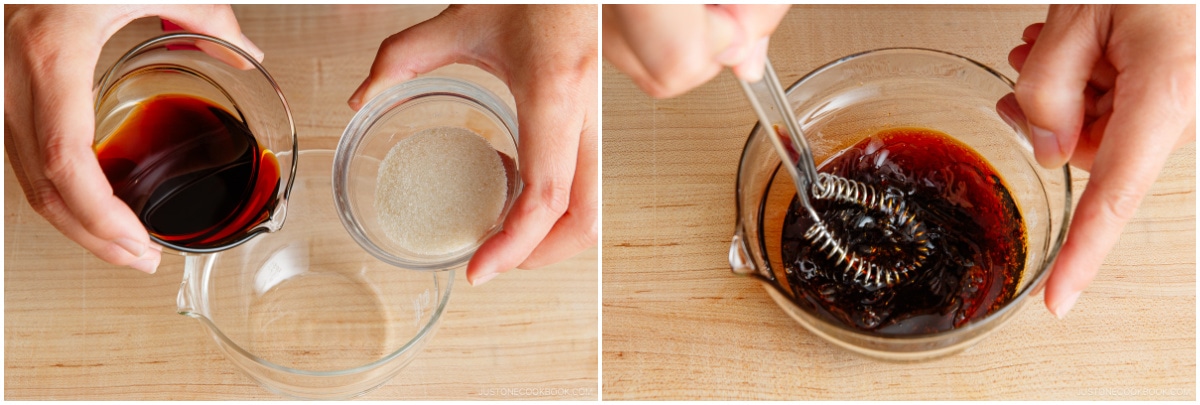
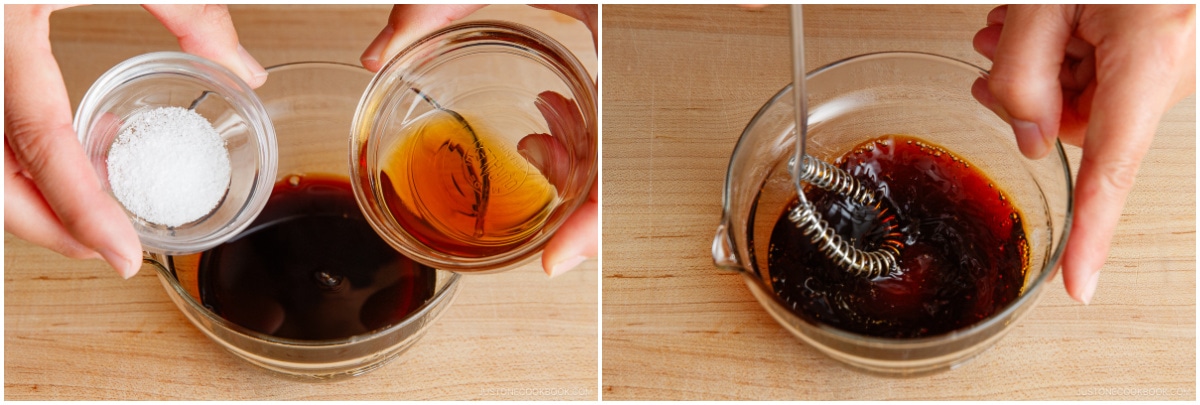
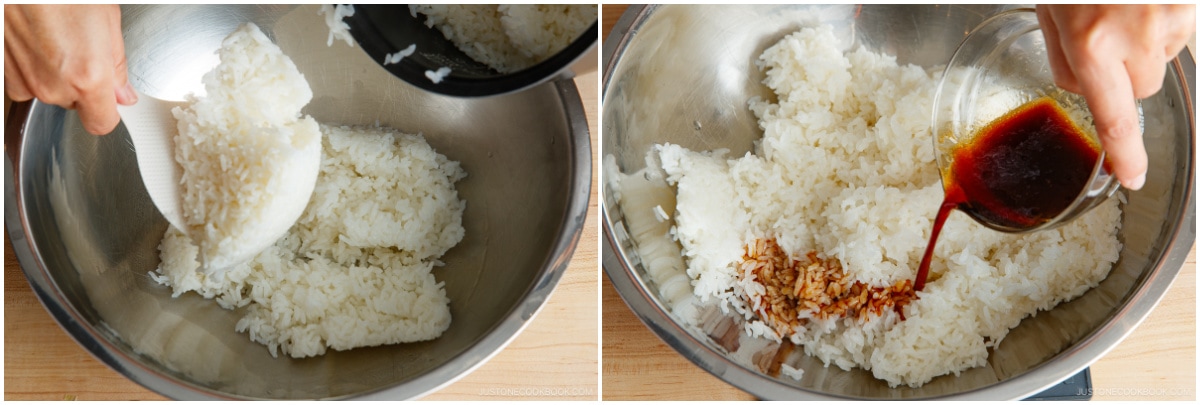
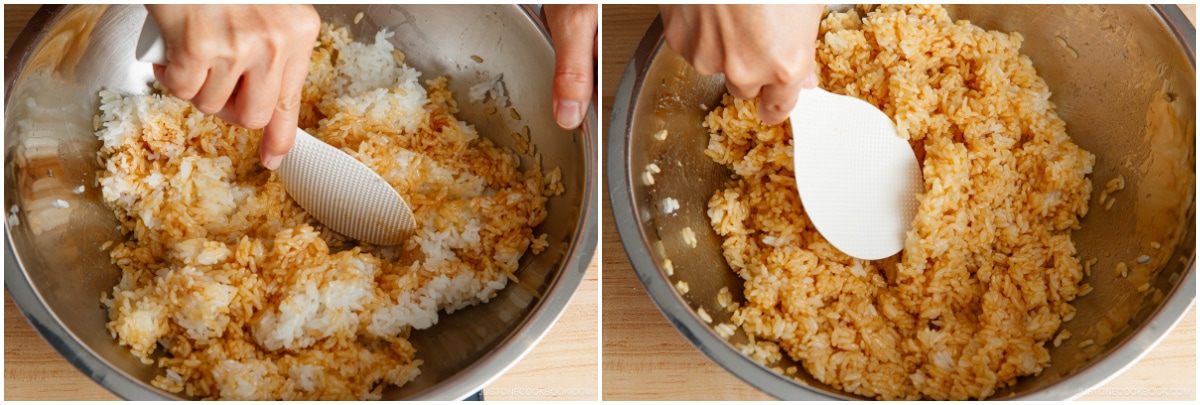
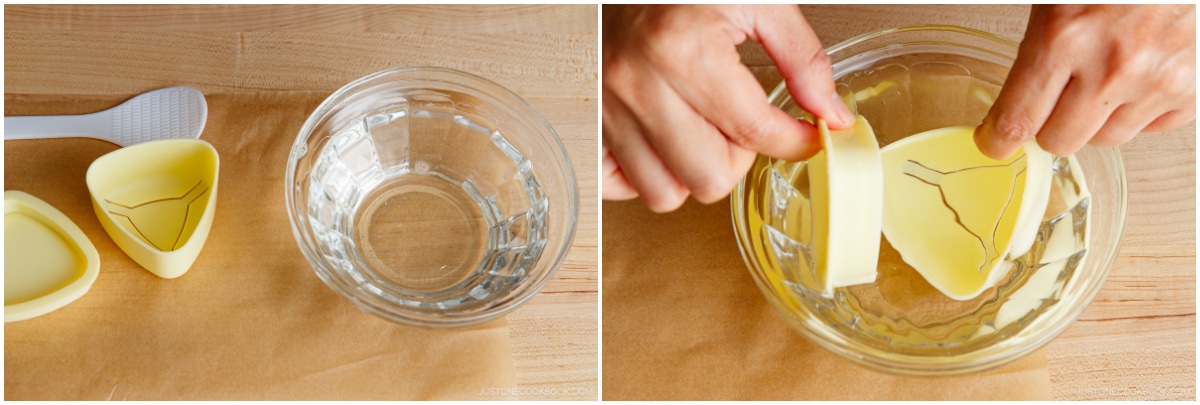
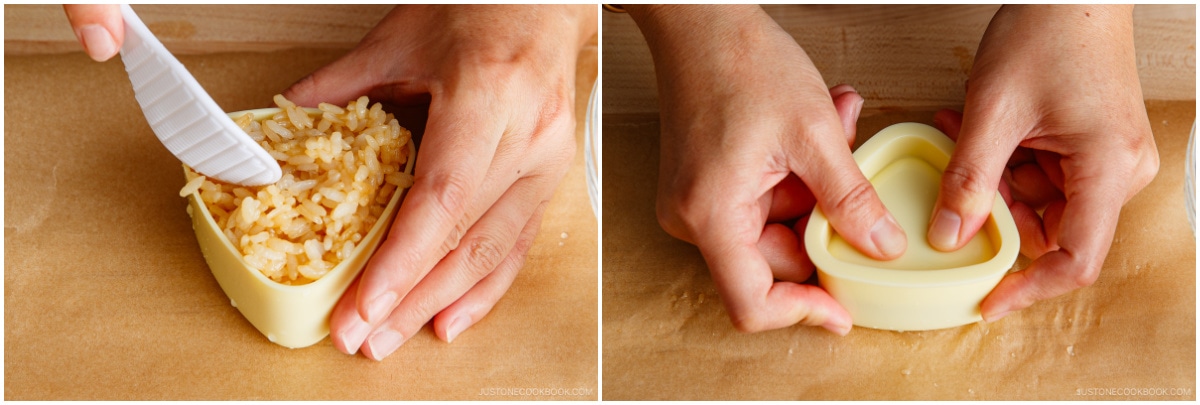
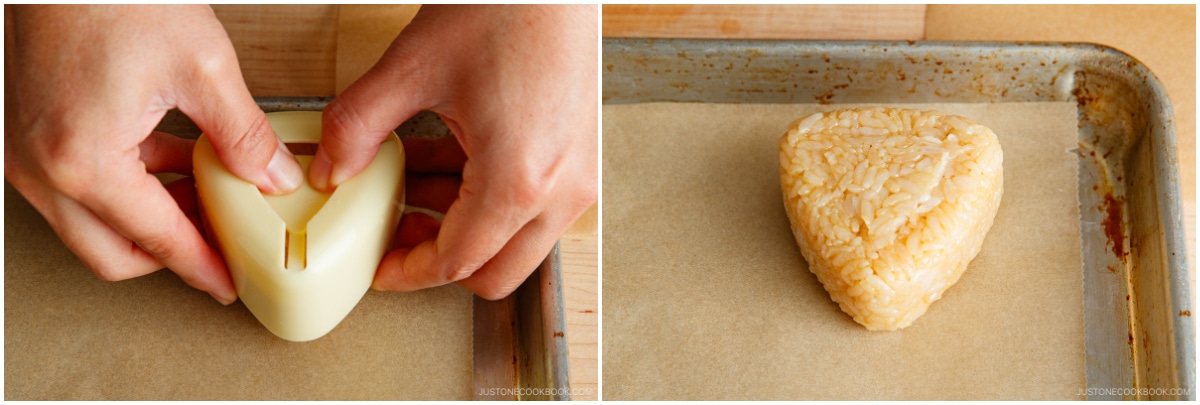
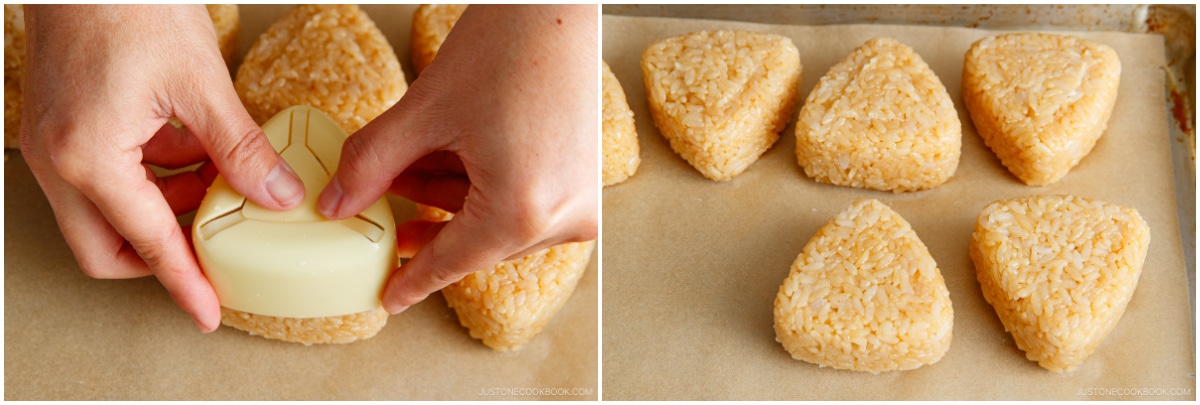
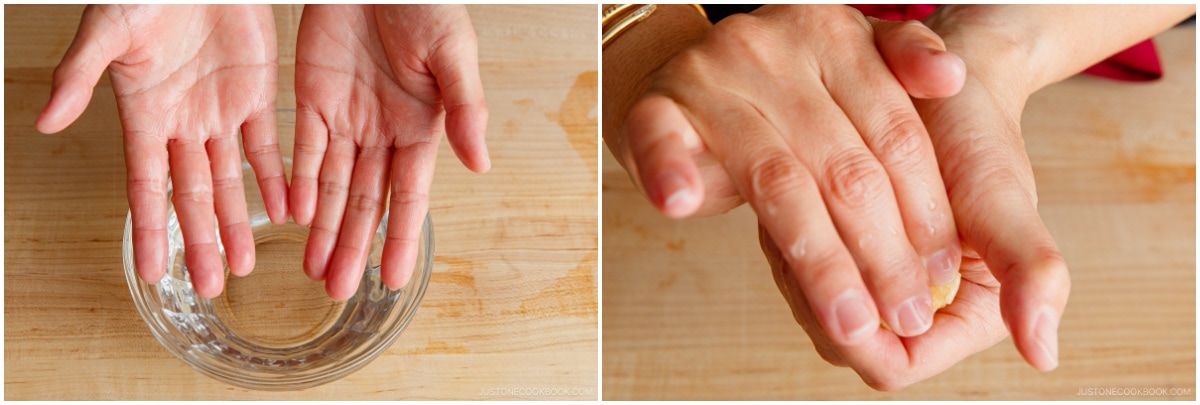
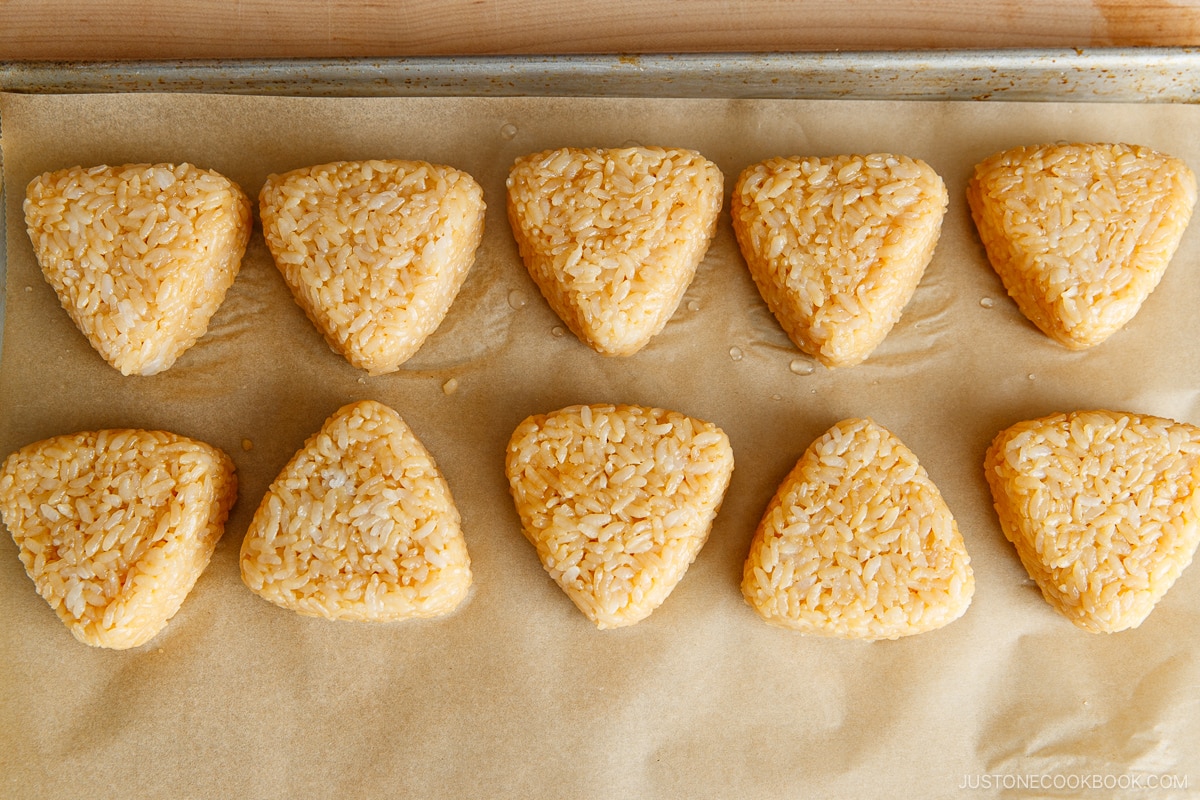
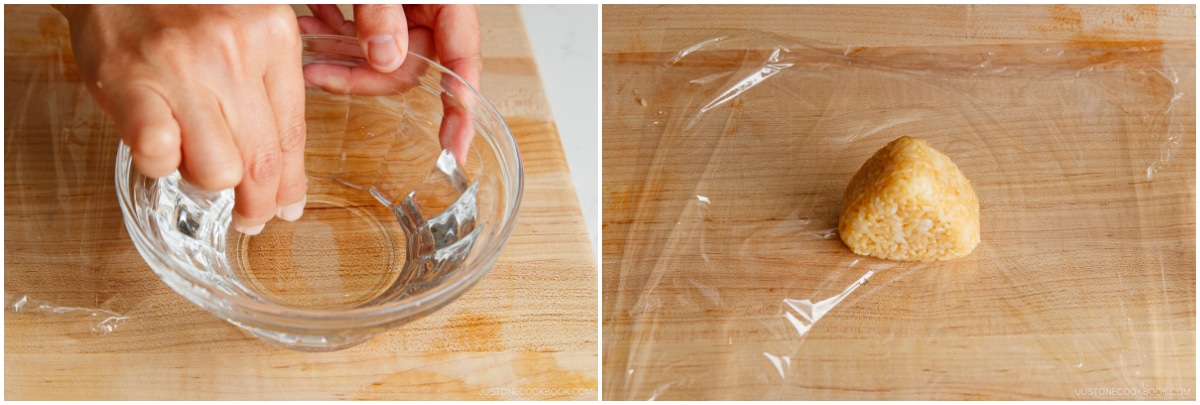
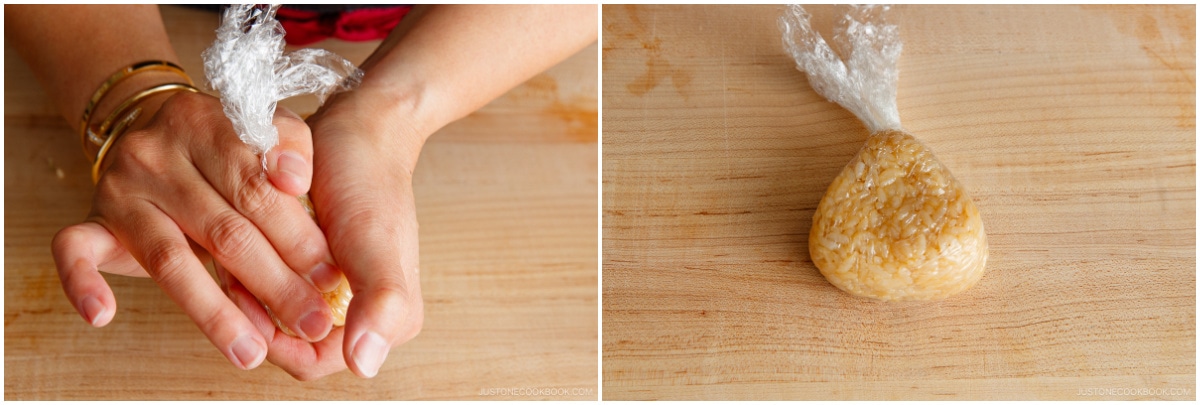
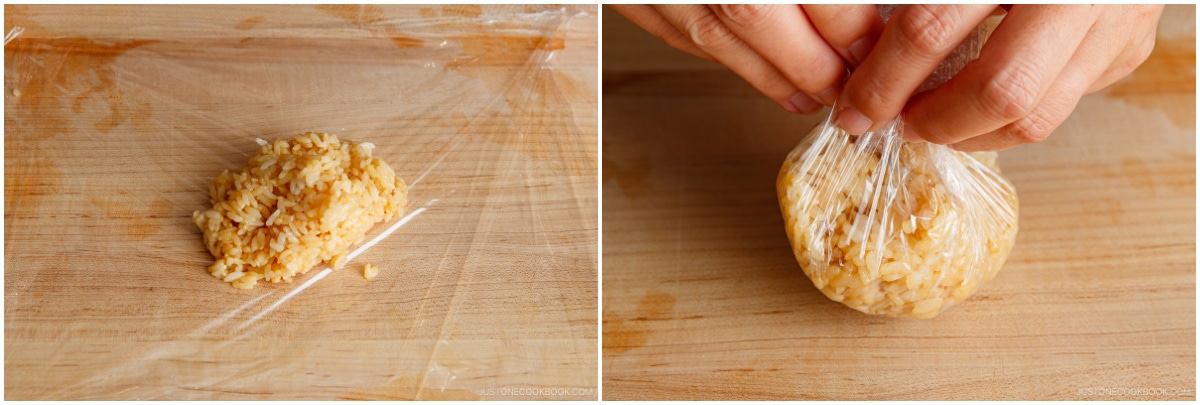
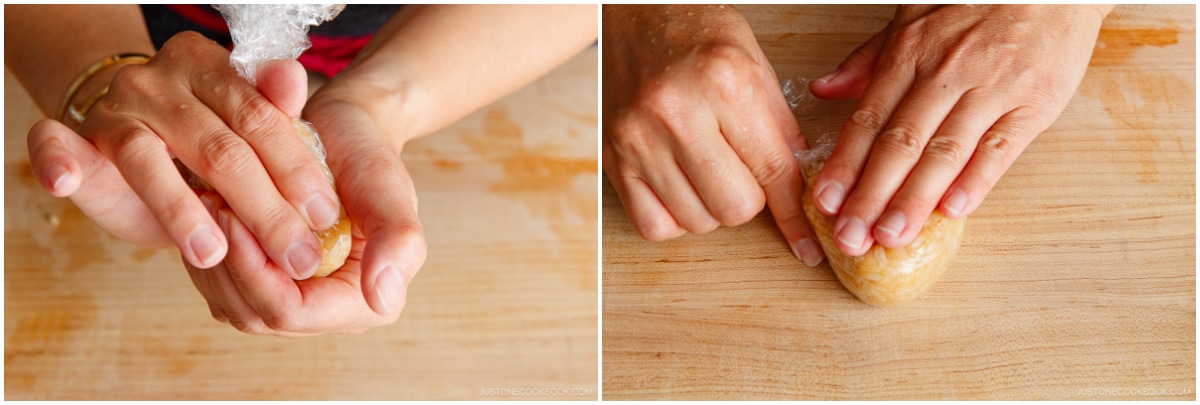
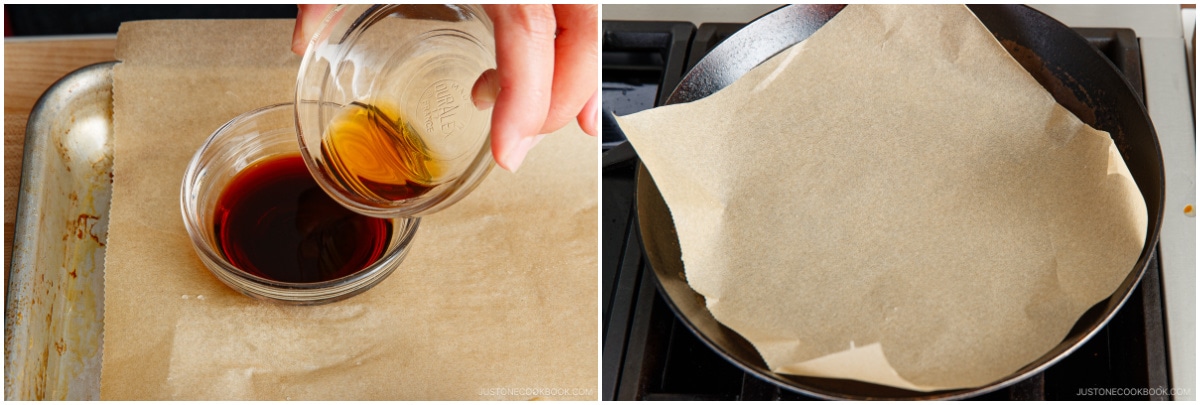
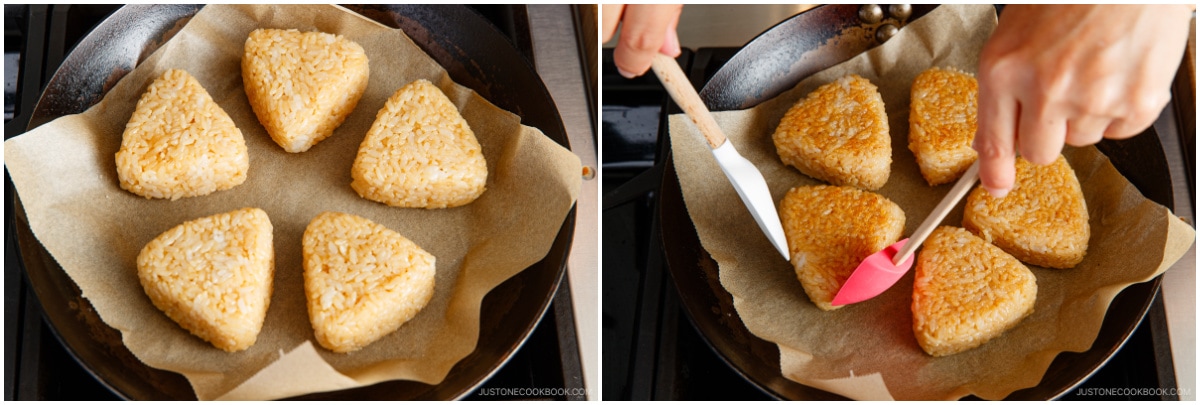
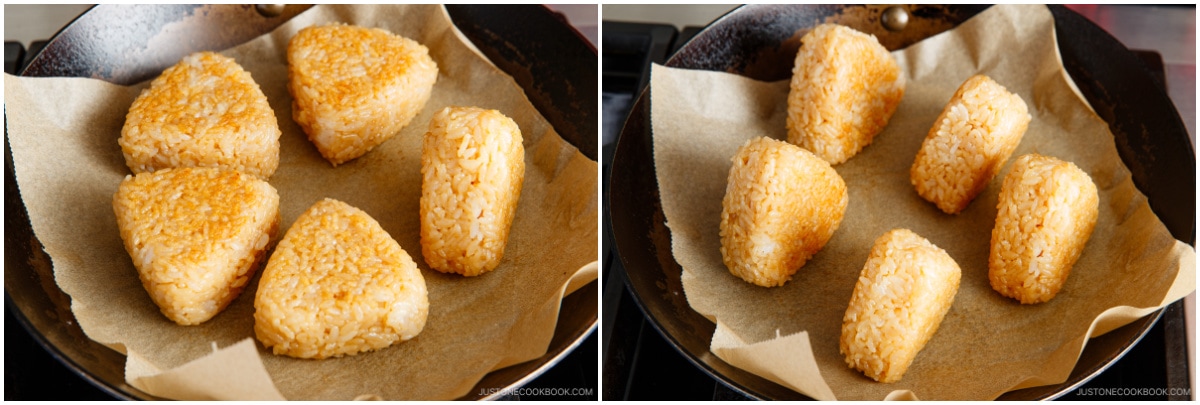
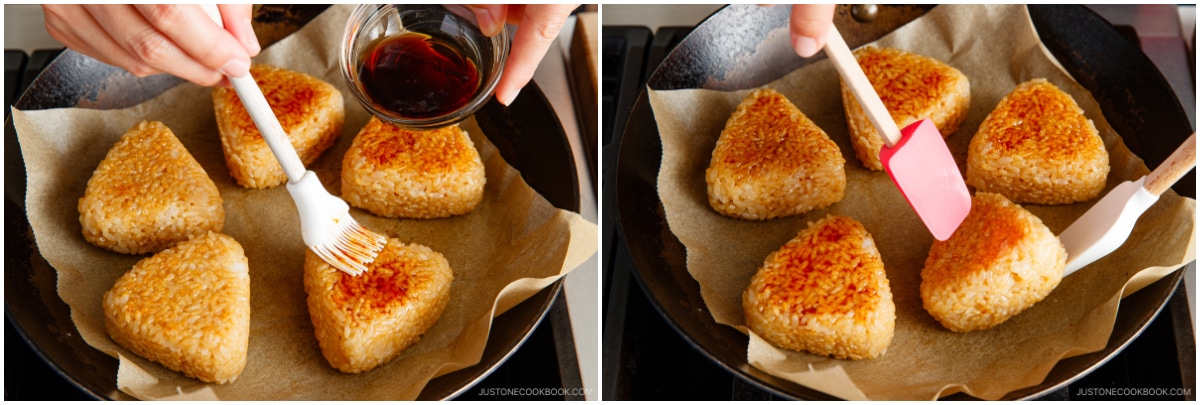
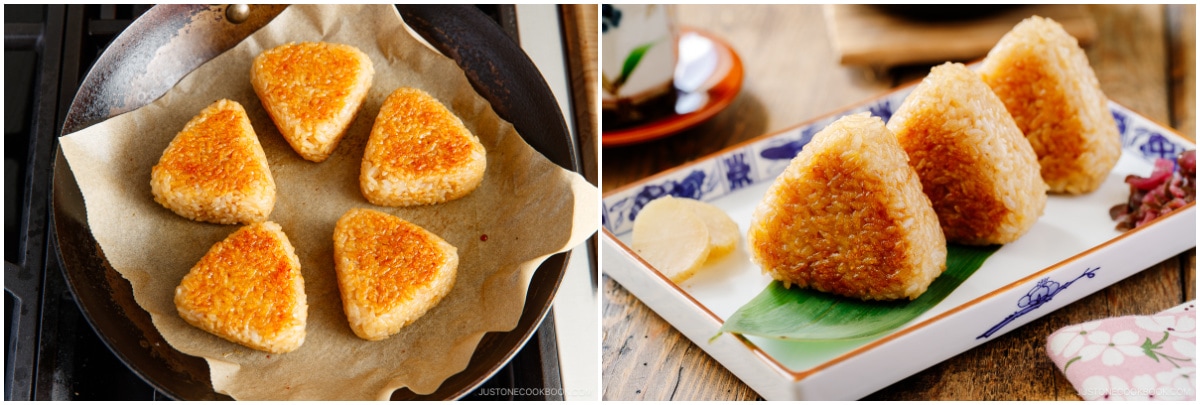
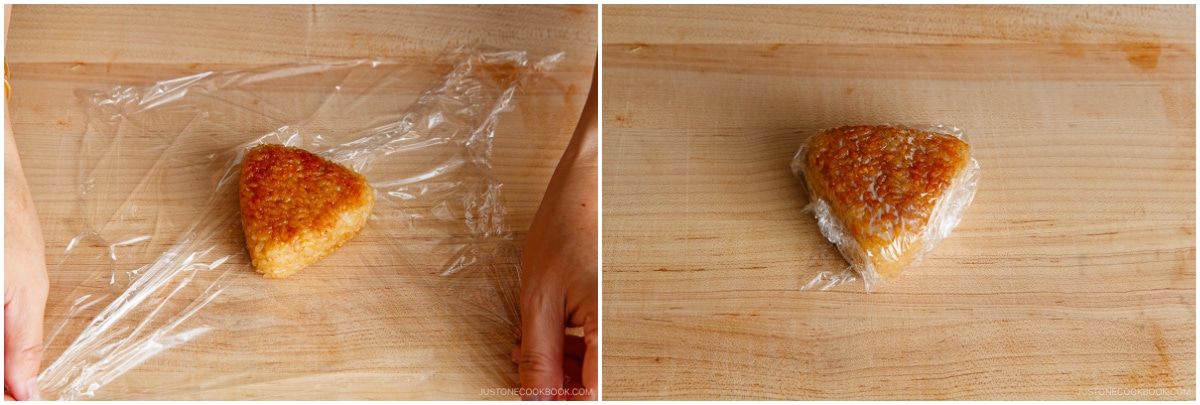











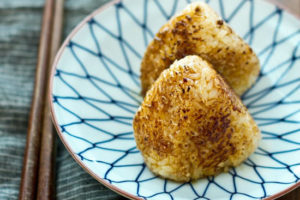
Waiting for your book full of thesse recipes……
Hi Elly! Thank you very much for your interest in Nami’s cookbook.💞
These Yaki Onigiri are not in the currently published cookbook, but we would like to share a link for Nami’s cookbook.
She has published two books so far.
Vol 1: https://amzn.to/3yL6bx3
Vol 2: https://amzn.to/2UbFPoT
We hope you enjoy these.
Hi! So excited to try this! I have seen recipes where they combine the rice and soy sauce before grilling instead of brushing it on so. Is that ok?
Hi Brendon, Sure. We think it’s up to your preference.😉
Your recipes look so amazing and I appreciate how organized and thoughtful the instructions are! I am so excited to make these this week 🙂 Would you mind sharing where you found your beautifully designed rice paddle in some of the photos? It looked like it had blue flowers and a wooden handle. I so greatly appreciate all of the other product recommendations and hope to buy my own donabe some day!
Hi Jen, Thank you very much for your kind feedback! We are glad to hear you enjoy our website.
The ceramic rice paddle with blue flowers was gifted from Nami’s grandma in Japan many years ago, and Nami doesn’t know where she got it from. Sorry!
Hi Jen, I forgot to mention where Nami gets her tableware, Donabe, etc.
Most of her tablewares were purchase in Japan, and she brings them back home to the US. Here is the post that talks about the good place to purchase inside and outside of Japan, and other links are for different items.
https://www.justonecookbook.com/the-ultimate-guide-to-japanese-tableware/
https://www.justonecookbook.com/how-to-cook-rice-in-donabe/
https://www.amazon.com/shop/justonecookbook
We hope this helps!
I’m just a “white guy”. I heard about “umami” and have been trying to identify it. (Salty, sour, sweet and bitter are easy to identify. We know where on the tongue they are.) I think, I’ve found the umami flavor but, I have to keep practicing..
I don’t wish to purchase MSG products.
-Is there another means to “instantly identify” umami? (I made a nice kobacha soup with red bean, dark soy, onion, rice.. I think, I tasted umami..)
..Sorry, this really doesn’t pertain to the wonderful rice balls (I plan to make soon!) –Just sort of frustrated hearing “umami” and, not really knowing what it is…
Hi Matthew, Thank you very much for writing to us. We understand your frustration. Umami is not easy to identify… We found some good website that explains about Umami and includes the list of the highest umami foods. We hope this can be helpful.❤️
https://www.umamiinfo.com/what/whatisumami/
https://www.thenibble.com/reviews/main/salts/umami-the-new-taste4.asp
Can you please share your Unagi Sauce.
Thank you..
Hi Marol, If you click homemade unagi sauce on the recipe card, it will jump to the website’s recipe. Here is the link, just in case🙂 : https://www.justonecookbook.com/unagi-sauce-2/ We hope this helps and you enjoy the Yaki Onigiri!
Can these be frozen after they are made? At my local Sanwa I buy them in the frozen section sometimes.
Hi Lori,
Sure. You can freeze them like regular cooked rice. 😉
Here is the post that explains how you store cooked rice. https://www.justonecookbook.com/how-to-freeze-rice/
We hope this helps!
Hi Nami,
You had a different recipe for the tare before but now I see you replaced it with your unagi sauce recipe – I know it uses the same ingredients, but I remember it not being as sweet and it cooking up a bit thicker. Would you mind posting the previous recipe please? It has always been a big hit with my family 🙂 Thanks!
Hi Janice! Funny, it’s actually the opposite. This recipe was only mentioning that I used Unagi Sauce (I like sweet sauce on my Yaki Onigiri). However, not everyone can get the bottled unagi sauce (or want to make the homemade uangi sauce – my favorite!), so I included the traditional soy sauce in the recipe (but I did say I used Unagi Sauce).
Maybe you were using someone’s recipe or you used my miso sauce one?
https://www.justonecookbook.com/miso-yaki-onigiri/
Those are the two I use for my Yaki Onigiri. And occasionally soy sauce but… I still love my Yaki Onigiri with Unagi Sauce.
Hope this helps!
Thanks Nami! Actually, after reading your comment, I remembered that I used your tare recipe from your yakitori recipe, which does use less sugar. I must be getting more forgetful as I get older, haha. Anyway, love your website, your recipes have definitely upped my cooking game! 🙂
Hi Janice!
Great! It all clear now, and you found the sauce that you were looking for!
Thank you for trying many of Nami’s recipes!🙂
Hi Nami, quick question. Is it possible to make these with brown rice? Is there any trick to getting brown rice to adhere to itself in the way that white rice can? Thanks!
Hi Dan! You can use short-grain brown rice and it works the same way as white short-grain rice. 🙂 Make sure to soak brown rice for 6 hours at least before cooking. It’s important! 🙂
I love grilled origin. I tried to make this last night but the rice fell apart in the pan. Any tips?
Hi Maggie! Usually, there are two possible reasons: 1) You’re not using Japanese short-grain rice. They stick to each other, so it’s hard to “fall apart”. 2) You’re not pressing enough pressure to make rice balls.
Do you think it could be either/both reason? 🙂
HI
Thank you for your feedback. I did use Japanese rice but it was in the fridge from night before, so it was more dry and hard. I used warm salt water to wet my hands. I will try fresh rice and press a bit harder next time! I will do my best!!
Hi Maggie! Thanks so much for letting me know. The refrigerator makes rice cold and dry, so even though you use the leftover the next day, I recommend freezing it. When you reheat, it’s just like freshly made steamed rice! 🙂
https://www.justonecookbook.com/how-to-freeze-rice/
Thank you for your feedback. I am Chinese and my husband is American and we live in Hong Kong. We eat rice almost everyday since kids are at home from social distancing. Sometimes I make Indian food or Thai food and we use long grain rice. We only cook Japanese short grain rice when I make Japanese dishes (from your blog). I have never thought of freezing rice since we eat it so often. I will try this next time if I make extra short grain rice when we do not finish! thank you!
Hi Maggie! I see! I think you’ll love freezing rice and will never put the rice in fridge once you start freezing. We usually portion out to 2 servings and put in a glass pyrex. It’s always moist and wonderful. Adjust the microwave time according to your Watt. Once you know how long it takes to perfectly reheat the rice, it’s fresh as new! Enjoy! 🙂
Nami-san, I made these with brown rice and baked them over a charcoal grill. Even my Japanese wife was impressed (and I give her credit for fixing my misshapen onigiri).
Hi Patrick! Hahahahaha! Thanks for sharing your cute story with us! I’m glad you and your wife enjoyed this dish! 🙂
The unsgi sauce was just right “umai”. After grilling the onigiri I started to paint it with the unsgi sauce . . . I think I over did it (it tasted do good) the rice ball started to crumble due to the sake and miring . . . penitrating into the onigiri. Next time I’ll be a bit more stingy with the sauce. Again it tasted great other than the miss.
Hi Sadso! Haha! I know what you mean by brushing more sauce. I love the unagi sauce too… but adding liquid makes the rice separated so easily. 🙂
Made this for lunch today! Had Honey smoked salmon and left over bacon wrapped shrimp. I tucked those into the middle. I bought a mold to press the rice. The first one I did not press tight enough and during cooking is tried to come apart the rest I did a better job. The rice took longer to brown than I thought, maybe because of the amount of moisture. I have two left over as they are quite filling, what is the best way to store the left overs? I have them out to cool completely, thought I might wrap them individually in plastic wrap. What do you think?
This was a big hit at our house. Thank you for sharing. Jennifer
Hi Jennifer! Such delicious fillings! They sound delicious! I would wrap them individually in plastic wrap. As the rice hardens when chilled, my recommendation is to wrap rice balls in kitchen towel so they will be cool and safe but not cold in the fridge. That way the rice balls won’t become hard. HOpe this helps! Thank you fo your kind feedback!
Hi Nami! I love yaki onigiri and order it whenever I see it. Decided to try and make my own today and they came out great! I even made the unagi sauce since I didn’t want to use just shoyu. Thanks again for a great and easy recipe. Will definitely make this again!
Hi Vicky! Thank you so much for trying this recipe and for your kind feedback! I’m so glad you liked the Yaki Onigiri made with the homemade unagi sauce! 🙂
Thank you so much for this wonderful recipe!
I made the udon from scratch and these yaki onigiri today and I am so very happy with the results. These were a little bit trickier (especially not destroying them in the pan …..) but your instructions were so clear and helpful and the result was amazing! Especially since the recipe seems so simple, but I recommend this to anyone, it’s such a delicious snack, I wish I had made many more. The most work is really just shaping the onigiri, everything else was very easy and it’s super worth the effort.
Thank you so so much and all the best!
Hi Matti! I’m glad to hear both recipes came out well. I hope you try my miso yaki onigiri too. So delicious. I can eat it every day… 😀 Thank you for trying my recipes!! xo
Mine totally fell apart in the skillet. I do like the flavor but the form was a disaster.
Hi Joe! Thank you for trying this recipe! I think I know the reason… you didn’t use Japanese short-grain rice. Rice never “fall apart” when you use the Japanese short-grain rice. Each kernel of rice sticks to each other so when you make it into a rice ball, it stays in the ball shape. 🙂
I don’t think that was it. Japanese short-grain rice is known as sushi rice outside of japan. Mine had the same problem. Unless I made them incredibly compact together by forming them over and over, they would rip at some side seam and completely fall apart in the pan.
Delicious, but very messy. Almost feel like just not even forming them into balls and just pouring some delicious unagi sauce and sauteeing it all up in a little oil. Even the ones that did stick together eventually fell apart in my hands as well.
Hi Freja! I’m a bit concerned that this rice is labeled as short grain rice… there is no way rice is not sticking when you form into a ball. It’s nature to stick without any work. You add some gentle presssure and it remains a ball shape (or any shape). It won’t fall apart. So I’m really worried that it’s not the right type of rice and marked as sushi rice. How can we make sushi if rice is not sticky…. impossible…. I’m so sorry about the mess and you had to go through this. It should not be so hard.
Old comment, but this is a problem on your end. I had no issues whatsoever. My guess is the heat of your pan was not correct. If you have to poke and prod at it without it getting crisp (with the crust solidifying the ball) then that would be my guess.